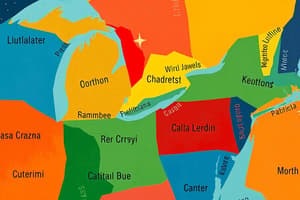Podcast
Questions and Answers
What does BPH primarily refer to in a clinical context?
What does BPH primarily refer to in a clinical context?
- Histological diagnosis of prostatic enlargement (correct)
- Benign obstruction due to bladder neck problems
- Benign Prostatic Hyperplasia as a symptom complex
- Benign enlargement of the prostate without histological diagnosis
Which of the following is a characteristic of Lower Urinary Tract Symptoms (LUTS)?
Which of the following is a characteristic of Lower Urinary Tract Symptoms (LUTS)?
- Includes both storage and emptying symptoms (correct)
- Is always associated with BPH
- Exclusively caused by urinary tract infections
- Only presents as irritative symptoms
What conclusion can be drawn about the prevalence of histological BPH?
What conclusion can be drawn about the prevalence of histological BPH?
- It decreases after age 60
- It remains constant across all age groups
- It is only relevant for men over 80
- It significantly increases with age, particularly after 50 (correct)
Which risk factor is least likely to be associated with the development of BPH?
Which risk factor is least likely to be associated with the development of BPH?
Which of the following statements about surgical management of BPH is correct?
Which of the following statements about surgical management of BPH is correct?
Which term refers to the enlargement of the prostate without obstruction?
Which term refers to the enlargement of the prostate without obstruction?
In the context of BPH, what does the term 'static/dynamic components' refer to?
In the context of BPH, what does the term 'static/dynamic components' refer to?
Which of the following differential diagnoses is specifically related to conditions other than BPH?
Which of the following differential diagnoses is specifically related to conditions other than BPH?
What typical symptom may be associated with both BPH and other urinary conditions?
What typical symptom may be associated with both BPH and other urinary conditions?
What is the primary purpose of PSA in the context of prostate evaluation?
What is the primary purpose of PSA in the context of prostate evaluation?
Which of the following is NOT a component of the initial evaluation for BPH?
Which of the following is NOT a component of the initial evaluation for BPH?
How is treatment success for BPH primarily measured?
How is treatment success for BPH primarily measured?
The anatomical change associated with benign prostatic hyperplasia (BPH) is best described as:
The anatomical change associated with benign prostatic hyperplasia (BPH) is best described as:
Which of the following conditions can lead to an increase in PSA levels?
Which of the following conditions can lead to an increase in PSA levels?
What symptom severity score indicates moderate to severe symptoms in the IPSS assessment?
What symptom severity score indicates moderate to severe symptoms in the IPSS assessment?
What is the purpose of performing a cystoscopy during BPH evaluation?
What is the purpose of performing a cystoscopy during BPH evaluation?
What is characterized by the acronym BOO in relation to BPH?
What is characterized by the acronym BOO in relation to BPH?
Which choice lists the correct therapeutic options for managing mild to moderate BPH?
Which choice lists the correct therapeutic options for managing mild to moderate BPH?
What histological change is associated with BPH?
What histological change is associated with BPH?
What is the role of alpha-adrenergic blockers in the treatment of LUTS?
What is the role of alpha-adrenergic blockers in the treatment of LUTS?
Which isoenzyme is responsible for the conversion of testosterone to dihydrotestosterone (DHT)?
Which isoenzyme is responsible for the conversion of testosterone to dihydrotestosterone (DHT)?
What effect does DHT have on the androgen receptor compared to testosterone?
What effect does DHT have on the androgen receptor compared to testosterone?
What is the primary benefit of combination therapy with Doxazosin and Finasteride?
What is the primary benefit of combination therapy with Doxazosin and Finasteride?
What is a key effect of combination treatment with Tamsulosin and Detrol® for men with bladder outlet obstruction (BOO)?
What is a key effect of combination treatment with Tamsulosin and Detrol® for men with bladder outlet obstruction (BOO)?
What is the rationale behind using 5-reductase inhibitors in treating BPH?
What is the rationale behind using 5-reductase inhibitors in treating BPH?
How do alpha-adrenergic blockers affect the treatment of acute urinary retention (AUR)?
How do alpha-adrenergic blockers affect the treatment of acute urinary retention (AUR)?
What physiological effect does the DHT/androgen receptor complex have?
What physiological effect does the DHT/androgen receptor complex have?
Which receptors are primarily involved in mediating irritative symptoms during LUTS?
Which receptors are primarily involved in mediating irritative symptoms during LUTS?
Which of the following is NOT an effect of anticholinergic therapy in managing bladder outlet obstruction?
Which of the following is NOT an effect of anticholinergic therapy in managing bladder outlet obstruction?
Flashcards
Benign Prostatic Hyperplasia (BPH)
Benign Prostatic Hyperplasia (BPH)
An enlargement of the prostate gland due to non-cancerous growth, often leading to urinary issues.
Lower Urinary Tract Symptoms (LUTS)
Lower Urinary Tract Symptoms (LUTS)
Symptoms related to problems with the bladder and urethra (the tube from the bladder to the outside of the body), including difficulty urinating.
Prostatism
Prostatism
Symptoms related to bladder outlet obstruction due to prostate enlargement.
Prevalence of BPH
Prevalence of BPH
Signup and view all the flashcards
Risk Factors for BPH
Risk Factors for BPH
Signup and view all the flashcards
Differential Diagnosis
Differential Diagnosis
Signup and view all the flashcards
BPH vs. Prostate Cancer
BPH vs. Prostate Cancer
Signup and view all the flashcards
BPE
BPE
Signup and view all the flashcards
BPO
BPO
Signup and view all the flashcards
Medical Therapy for BPH
Medical Therapy for BPH
Signup and view all the flashcards
LUTS
LUTS
Signup and view all the flashcards
Treatment Goals for BPH
Treatment Goals for BPH
Signup and view all the flashcards
Initial Evaluation (BPH)
Initial Evaluation (BPH)
Signup and view all the flashcards
AUA-SS
AUA-SS
Signup and view all the flashcards
-Adrenergic Blockers
-Adrenergic Blockers
Signup and view all the flashcards
5-Reductase Inhibitors
5-Reductase Inhibitors
Signup and view all the flashcards
Anticholinergic Therapy
Anticholinergic Therapy
Signup and view all the flashcards
DHT Action
DHT Action
Signup and view all the flashcards
Combination Therapy for BPH
Combination Therapy for BPH
Signup and view all the flashcards
MTOPS Study
MTOPS Study
Signup and view all the flashcards
Finasteride
Finasteride
Signup and view all the flashcards
Doxazosin
Doxazosin
Signup and view all the flashcards
Detrol® and Tamsulosin Combination
Detrol® and Tamsulosin Combination
Signup and view all the flashcards
Effects of Combination Therapy
Effects of Combination Therapy
Signup and view all the flashcards
Study Notes
Benign Prostatic Hyperplasia (BPH)
- BPH is a histological diagnosis
- BPH is enlargement due to benign growth (can include obstruction)
- BPH is often associated with "prostatism" and/or lower urinary tract symptoms (LUTS)
- Risk factors for BPH increase with age
- Symptoms include irritative (storage) and obstructive symptoms common in LUTS, such as nocturia and urgency.
Learning Outcomes
- Able to describe BPH
- Able to analyze risk factors and developmental period for BPH
- Able to describe lower urinary tract symptoms
- Able to evaluate a patient with BPH
- List medical therapies
- List surgical management types
What is BPH?
- BPH is a histological diagnosis.
- Prostate enlargement can occur without obstruction.
- Bladder outlet obstruction (BOO) may be present and can be static or dynamic (components).
LUTS
- Lower urinary tract dysfunction symptoms (LUTS) involve both storage and emptying symptoms.
- Symptoms may include nocturia, urgency, and difficulty urinating, related to BPH, but not exclusive to it.
- LUTS are frequently included in patient evaluations.
Differential Diagnosis
- Urethral stricture is a possible differential diagnosis.
- Bladder neck contracture is a possible differential diagnosis.
- Bladder stones are a possible differential diagnosis.
- Urinary tract infection is a possible differential diagnosis.
- Interstitial cystitis is a possible differential diagnosis.
- Neurogenic bladder is a possible differential diagnosis.
- Inflammatory prostatitis is a possible differential diagnosis.
- Medications are a possible differential diagnosis.
- Carcinoma of the prostate is a possible differential diagnosis.
- Carcinoma in situ of the bladder is a possible differential diagnosis.
Prevalence of Histologic BPH
- Prevalence of BPH increases with age.
- Relevant data points from various studies are presented graphically, showing prevalence rates across different age groups.
Old Paradigm Versus Subsequent Paradigm
- Old paradigm viewed BPH as simple enlargement.
- Subsequent paradigm recognized that a prostate might be small with receptors.
- A subsequent view includes the enlarged prostate with a different set of possible diagnostic markers and clinical considerations.
BPH/LUTS Pathophysiology
- Prostate hyperplasia initiates a chain of events.
- BOO occurs as a result of obstruction.
- Aging effects may affect the detrusor response.
- Primary bladder disease may be present.
- Polyuria can occur as a result of any of the conditions linked.
Initial Evaluation
- Detailed medical history is important.
- Physical exam, including DRE and neurologic exam, is needed.
- Urinalysis is part of the evaluation.
- Serum creatinine is no longer mandatory but may be important in some cases.
- PSA is a marker for prostate cancer and is usually evaluated.
- Symptom assessment using the AUA-SS score is essential.
PSA
- PSA is produced by epithelial cells.
- It cleaves semen.
- PSA is often bound to other proteins (ACT).
- Elevated PSA can be due to malignancy, hyperplasia, or infection/inflammation.
Clinical & Anatomical and Pathophysiologic Changes
- Histological changes in the prostate gland, such as stromoglandular hyperplasia, occur.
- Clinical symptoms such as bothersome LUTS can be part of the clinical evaluation.
- Anatomical enlargement (BPE) may occur as a result of the histological changes.
- Pathophysiological compression of the urethra can result in BOO.
Goals of Therapy for BPH
- Reduce symptoms (IPSS/AUA scores).
- Improve quality of life (QOL).
- Prevent further prostate growth.
- Increase maximum urinary flow rate and relieve obstruction.
- Prevent long-term complications related to BPH.
- Acceptable adverse events profile.
Medical Treatments for BPH, LUTS, BOO
- Alpha-adrenergic blockers affect the dynamic component, while 5-alpha-reductase inhibitors impact the anatomic component.
- Anticholinergic therapy is effective in reducing storage symptoms often associated with BPH.
Role of α-Adrenoreceptors
- Alpha-1 (α-1) adrenoreceptors are involved in smooth muscle contraction in the prostate.
- Alpha-1 receptors in the spinal cord influence the detrusor response.
- Different alpha subtypes in the urinary tract and prostate can have various effects which can be affected by therapies.
Dihydrotestosterone (DHT) Action
- Testosterone is converted to DHT by 5-alpha-reductase.
- DHT binds to the androgen receptor.
- DHT has a higher affinity than testosterone.
- DHT modulates gene expression in a significant way.
Rationale for Combination Therapy
- 5-alpha reductase inhibitors arrest disease progression, while alpha-blockers rapidly relieve symptoms.
- Combination therapy is most effective for preventing clinical progression in specific or selected patients.
Doxazosin/Finasteride/Combination
- MTOPS (Medical Treatment of Prostatic Symptoms) studied a combination of doxazosin and finasteride.
- The method significantly reduces clinical BPH progression.
- This approach can reduce the risk of AUR and other invasive therapies.
Combination Treatment with-Blocker Plus Anticholinergic for Bladder Outlet Obstruction
- The proposed combination of Detrol® and Tamsulosin for bladder outlet obstruction (BOO) and overactive detrusor (OAB) has a positive impact on quality of life.
- Outcomes include increased bladder capacity, no acute urinary retention, no significant impact on urinary flow or post-void residual urine, and a safe treatment option.
Surgical Therapy
- Common surgical therapies, such as TURP, TUVP, Gyrus, TUIP surgeries etc.
- Laser procedures, open procedures, such as suprapubic, retropubic, perineal and minimally-invasive procedures including TUMT, TUNA, WIT, TEAP, Botox, and ILC are also options.
Transurethral Resection of the Prostate (TURP)
- Advantages include availability of long-term outcome data, good clinical results, treating smaller prostates, low retreatment rate, and low mortality.
- Disadvantages include retrograde ejaculation and bleeding, including potential TUR Syndrome.
BPH and Erectile Dysfunction
- LUTS and erectile dysfunction (ED) are common in older men.
- Sexual function declines with age.
- ED is often associated with chronic diseases such as diabetes and hypertension.
- A possible link exists between LUTS and ED.
- Possible underlying mechanisms for co-existence of ED and BPH, such as diminished quality of life, increased sympathetic tone, ischemia/endothelial dysfunction, or alteration of NO pathways.
Take Home Messages
- Aging increases the prevalence of BPH.
- Not all men with LUTS have BPH.
- Not all men with BPH have LUTS.
- Consider combination therapy in specific cases.
- Quality of life is a significant factor in treatment decisions.
Additional Information
- Presented data show the response to various treatments over time.
Studying That Suits You
Use AI to generate personalized quizzes and flashcards to suit your learning preferences.




